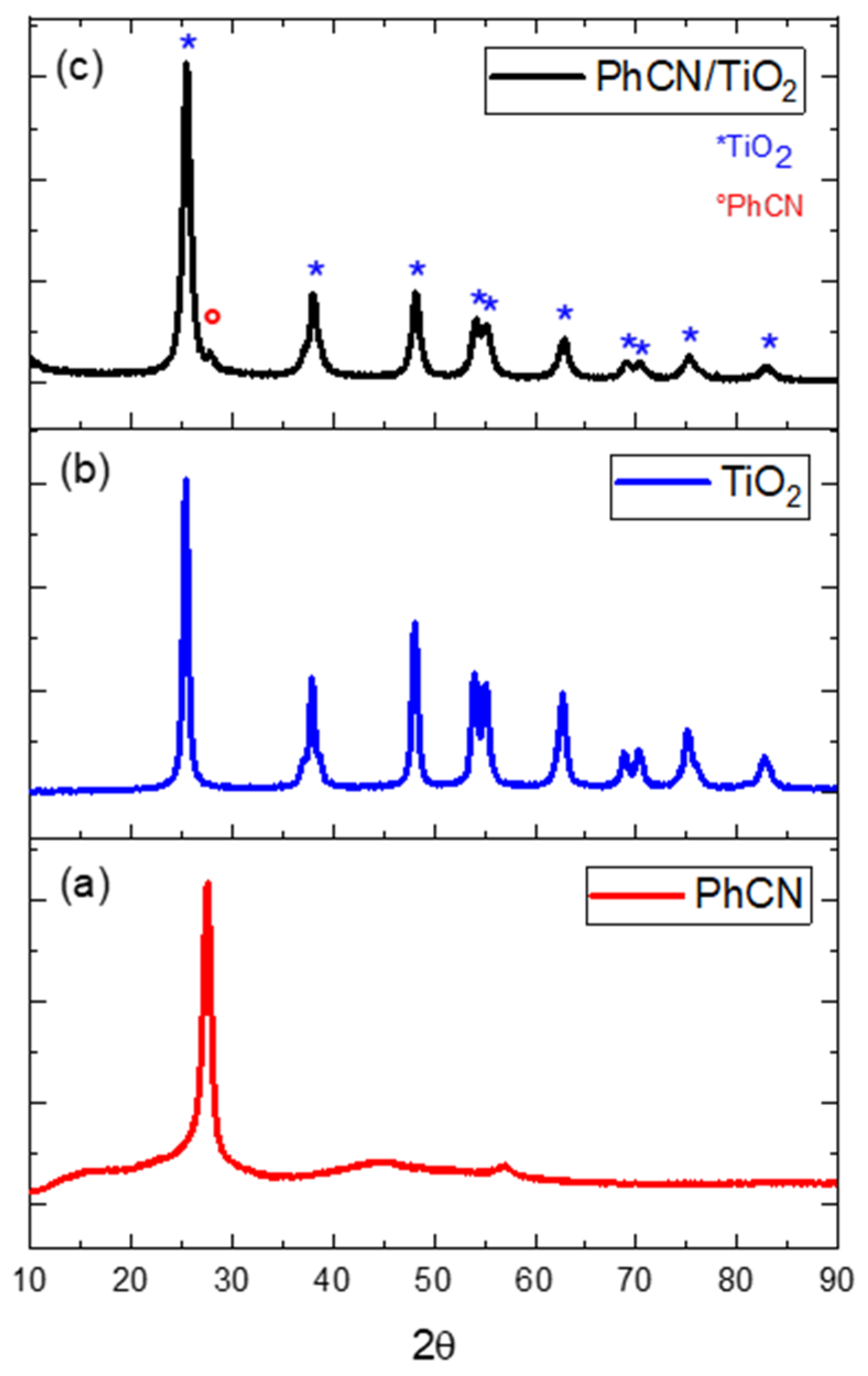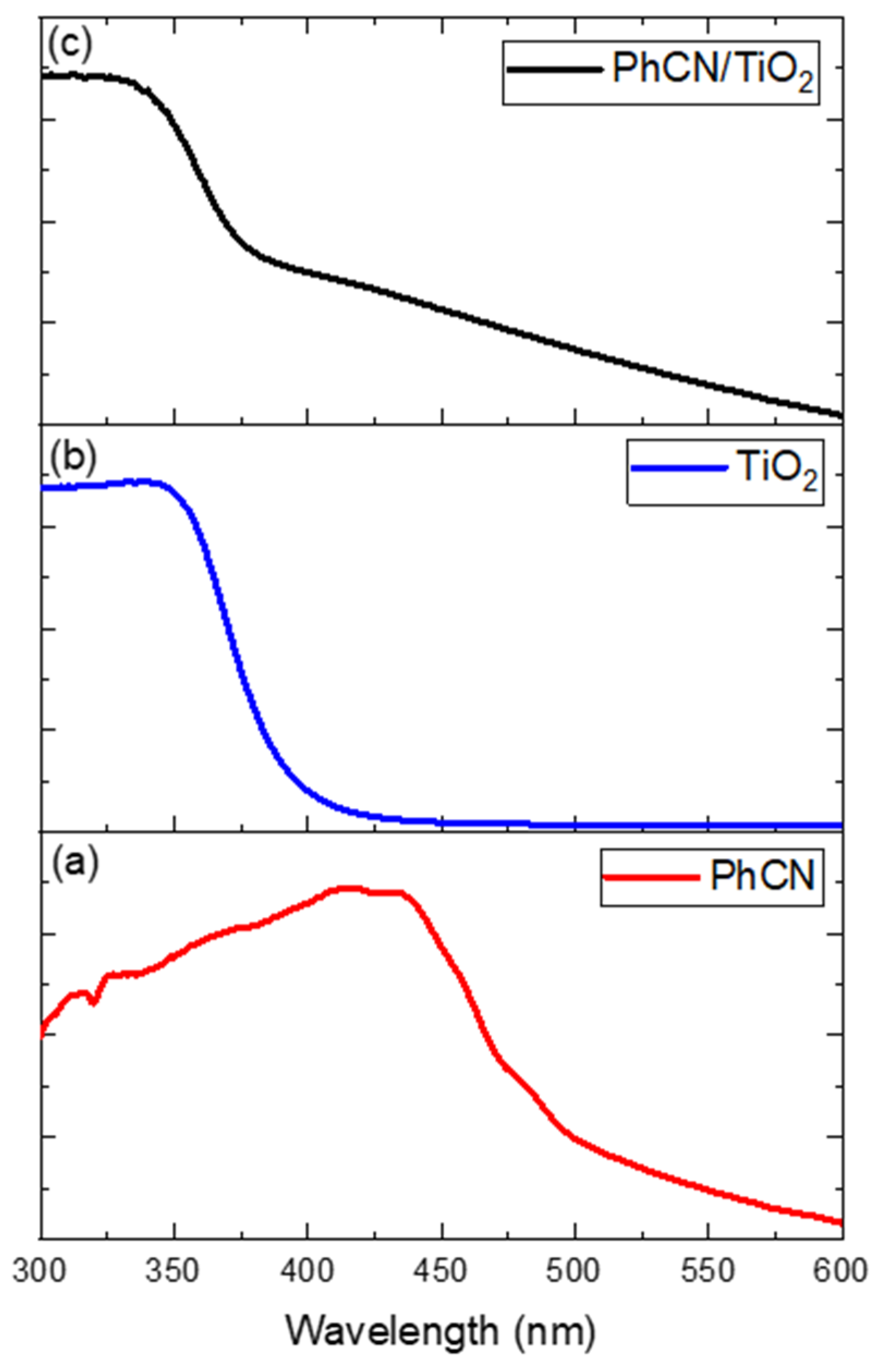Visible Light-Mediated Inactivation of H1N1 Virus UsingPolymer-Based Heterojunction Photocatalyst
Abstract
:1. Introduction
2. Materials and Methods
2.1. Materials
Cells and Viruses
2.2. Synthesis of the Photocatalyst
2.2.1. Synthesis of PhCN
2.2.2. Synthesis of PhCN/TiO2
2.3. Characterization Techniques of the Photocatalyst
Cytopathic Effect Assay on MDCK-2 Cells and Measurement of the Photocatalytic Activity
3. Results and Discussion
3.1. Photocatalytic Inactivation of the Virus
3.1.1. Cytotoxicity Test
3.1.2. Virus Inactivation
4. Conclusions
Author Contributions
Funding
Institutional Review Board Statement
Informed Consent Statement
Data Availability Statement
Conflicts of Interest
References
- Soni, V.; Khosla, A.; Singh, P.; Nguyen, V.-H.; Van Le, Q.; Selvasembian, R.; Hussain, C.M.; Thakur, S.; Raizada, P. Current perspective in metal oxide based photocatalysts for virus disinfection: A review. J. Environ. Manag. 2022, 308, 114617. [Google Scholar] [CrossRef] [PubMed]
- Cesewski, E.; Johnson, B.N. Electrochemical biosensors for pathogen detection. Biosens. Bioelectron. 2020, 159, 112214. [Google Scholar] [CrossRef] [PubMed]
- Ateia, M.; Alalm, M.G.; Awfa, D.; Johnson, M.S.; Yoshimura, C. Modeling the degradation and disinfection of water pollutants by photocatalysts and composites: A critical review. Sci. Total. Environ. 2020, 698, 134197. [Google Scholar] [CrossRef]
- Ren, H.; Koshy, P.; Chen, W.-F.; Qi, S.; Sorrell, C.C. Photocatalytic materials and technologies for air purification. J. Hazard. Mater. 2017, 325, 340–366. [Google Scholar] [CrossRef] [PubMed]
- Cedergren, M.I.; Selbing, A.J.; Löfmanb, O.; Källen, B.A. Chlorination Byproducts and Nitrate in Drinking Water and Risk for Congenital Cardiac Defects. Environ. Res. 2002, 89, 124–130. [Google Scholar] [CrossRef]
- Hijnen, W.A.M.; Beerendonk, E.F.; Medema, G.J. Inactivation credit of UV radiation for viruses, bacteria and protozoan (oo) cysts in water: A review. Water Res. 2006, 40, 3–22. [Google Scholar] [CrossRef]
- Li, D.; Gu, A.Z.; He, M.; Shi, H.-C.; Yang, W. UV inactivation and resistance of rotavirus evaluated by integrated cell culture and real-time RT-PCR assay. Water Res. 2009, 43, 3261–3269. [Google Scholar] [CrossRef]
- Yu, B.; Hu, Z.; Liu, M.; Yang, H.; Kong, Q.; Liu, Y. Review of research on air-conditioning systems and indoor air quality control for human health. Int. J. Refrig. 2009, 32, 3–20. [Google Scholar] [CrossRef]
- Innocenzi, P.; Stagi, L. Carbon-based antiviral nanomaterials: Graphene, C-dots, and fullerenes. A perspective. Chem. Sci. 2020, 11, 6606–6622. [Google Scholar] [CrossRef]
- Hasija, V.; Nguyen, V.-H.; Kumar, A.; Raizada, P.; Krishnan, V.; Khan, A.A.P.; Singh, P.; Lichtfouse, E.; Wang, C.; Huong, P.T. Advanced activation of persulfate by polymeric g-C3N4 based photocatalysts for environmental remediation: A review. J. Hazard. Mater. 2021, 413, 125324. [Google Scholar] [CrossRef]
- Nandan, A.; Siddiqui, N.; Singh, C.; Aeri, A.; Gwenzi, W.; Ighalo, J.O.; Nagliate, P.d.C.; Meili, L.; Singh, P.; Chaukura, N.; et al. COVID-19 pandemic in Uttarakhand, India: Environmental recovery or degradation? J. Environ. Chem. Eng. 2021, 9, 106595. [Google Scholar] [CrossRef] [PubMed]
- Mahmoudian-Boroujerd, L.; Karimi-Jashni, A.; Hosseini, S.N.; Paryan, M. Optimization of rDNA degradation in recombinant Hepatitis B vaccine production plant wastewater using visible light excited Ag-doped TiO2 nanophotocatalyst. Process. Saf. Environ. Prot. 2019, 122, 328–338. [Google Scholar] [CrossRef]
- Martin, I.T.; Dressen, B.; Boggs, M.; Liu, Y.; Henry, C.S.; Fisher, E.R. Plasma Process. Polym. 4/2007. Plasma Process. Polym. 2007, 4, 397–401. [Google Scholar] [CrossRef]
- Cui, H.; Jiang, J.; Gu, W.; Sun, C.; Wu, D.; Yang, T.; Yang, G. Photocatalytic Inactivation Efficiency of Anatase Nano-TiO2 Sol on the H9N2 Avian Influenza Virus. Photochem. Photobiol. 2010, 86, 1135–1139. [Google Scholar] [CrossRef]
- Nakano, R.; Ishiguro, H.; Yao, Y.; Kajioka, J.; Fujishima, A.; Sunada, K.; Minoshima, M.; Hashimoto, K.; Kubota, Y. Photocatalytic inactivation of influenza virus by titanium dioxide thin film. Photochem. Photobiol. Sci. 2012, 11, 1293–1298. [Google Scholar] [CrossRef]
- Chen, D.; Cheng, Y.; Zhou, N.; Chen, P.; Wang, Y.; Li, K.; Huo, S.; Cheng, P.; Peng, P.; Zhang, R.; et al. Photocatalytic degradation of organic pollutants using TiO2-based photocatalysts: A review. J. Clean. Prod. 2020, 268, 121725. [Google Scholar] [CrossRef]
- Rueda-Marquez, J.J.; Levchuk, I.; Ibañez, P.F.; Sillanpää, M. A critical review on application of photocatalysis for toxicity reduction of real wastewaters. J. Clean. Prod. 2020, 258, 120694. [Google Scholar] [CrossRef]
- Hitam, C.; Jalil, A. A review on exploration of Fe2O3 photocatalyst towards degradation of dyes and organic contaminants. J. Environ. Manag. 2020, 258, 110050. [Google Scholar] [CrossRef]
- Khan, I.; Saeed, K.; Khan, I. Review nanoparticles: Properties, applications and toxicities. Arab. J. Chem. 2019, 12, 908–931. [Google Scholar] [CrossRef]
- Mittal, A.; Mari, B.; Sharma, S.; Kumari, V.; Maken, S.; Kumari, K.; Kumar, N. Non-metal modified TiO2: A step towards visible light photocatalysis. J. Mater. Sci. Mater. Electron. 2019, 30, 3186–3207. [Google Scholar] [CrossRef]
- Singh, P.; Shandilya, P.; Raizada, P.; Sudhaik, A.; Rahmani-Sani, A.; Hosseini-Bandegharaei, A. Review on various strategies for enhancing photocatalytic activity of graphene based nanocomposites for water purification. Arab. J. Chem. 2018, 13, 3498–3520. [Google Scholar] [CrossRef]
- Yan, S.C.; Li, Z.S.; Zou, Z.G. Photodegradation performance of g-C3N4 fabricated by directly heating melamine. Langmuir 2009, 25, 10397–10401. [Google Scholar] [CrossRef] [PubMed]
- Stagi, L.; Chiriu, D.; Carbonaro, C.M.; Corpino, R.; Ricci, P.C. Structural and optical properties of carbon nitride polymorphs. Diam. Relat. Mater. 2016, 68, 84–92. [Google Scholar] [CrossRef]
- Ma, L.; Wang, G.; Jiang, C.; Bao, H.; Xu, Q. Synthesis of core-shell TiO2 @g-C3N4 hollow microspheres for efficient photocatalytic degradation of rhodamine B under visible light. Appl. Surf. Sci. 2018, 430, 263–272. [Google Scholar] [CrossRef]
- Ni, S.; Fu, Z.; Li, L.; Ma, M.; Liu, Y. Step-scheme heterojunction g-C3N4/TiO2 for efficient photocatalytic degradation of tetracycline hydrochloride under UV light. Colloids Surf. A Physicochem. Eng. Asp. 2022, 649, 129475. [Google Scholar] [CrossRef]
- Porcu, S.; Castellino, M.; Roppolo, I.; Carbonaro, C.M.; Palmas, S.; Mais, L.; Casula, M.F.; Neretina, S.; Hughes, R.A.; Secci, F.; et al. Highly efficient visible light phenyl modified carbon nitride/TiO2 photocatalyst for environmental applications. Appl. Surf. Sci. 2020, 531, 147394. [Google Scholar] [CrossRef]
- Porcu, S.; Roppolo, I.; Salaun, M.; Sarais, G.; Barbarossa, S.; Casula, M.F.; Carbonaro, C.M.; Ricci, P.C. Come to light: Detailed analysis of thermally treated Phenyl modified Carbon Nitride Polymorphs for bright phosphors in lighting applications. Appl. Surf. Sci. 2019, 504, 144330. [Google Scholar] [CrossRef]
- Bakbolat, B.; Daulbayev, C.; Sultanov, F.; Beissenov, R.; Umirzakov, A.; Mereke, A.; Bekbaev, A.; Chuprakov, I. Recent Developments of TiO2-Based Photocatalysis in the Hydrogen Evolution and Photodegradation: A Review. Nanomaterials 2020, 10, 1790. [Google Scholar] [CrossRef]
- Schiller, C.; Kainz, A.; Mynett, K.; Gescher, A. Assessment of viability of hepatocytes in suspension using the MTT assay. Toxicol. Vitr. 1992, 6, 575–578. [Google Scholar] [CrossRef]






| No Photocatalyst | Photocatalyst | Photocatalyst (Dark) | Photocatalyst (Light) | |
|---|---|---|---|---|
| Dark v 1:100 vs. Light v 1:100 | Dark v + photocatalyst 1:100 vs. Light v + photocatalyst 1:100 | Dark v + photocatalyst 1:100 vs. Dark v + 1:100 | Light v + photocatalyst 1:100 vs. Light v + 1:100 | |
| p value | 0.032 | 0.0051 | 0.0231 | <0.0001 |
| p value summary | * | ** | * | **** |
| Significantly different? (p < 0.05) | Yes | Yes | Yes | Yes |
Disclaimer/Publisher’s Note: The statements, opinions and data contained in all publications are solely those of the individual author(s) and contributor(s) and not of MDPI and/or the editor(s). MDPI and/or the editor(s) disclaim responsibility for any injury to people or property resulting from any ideas, methods, instructions or products referred to in the content. |
© 2023 by the authors. Licensee MDPI, Basel, Switzerland. This article is an open access article distributed under the terms and conditions of the Creative Commons Attribution (CC BY) license (https://creativecommons.org/licenses/by/4.0/).
Share and Cite
Porcu, S.; Maloccu, S.; Corona, A.; Hazra, M.; David, T.C.; Chiriu, D.; Carbonaro, C.M.; Tramontano, E.; Ricci, P.C. Visible Light-Mediated Inactivation of H1N1 Virus UsingPolymer-Based Heterojunction Photocatalyst. Polymers 2023, 15, 2536. https://doi.org/10.3390/polym15112536
Porcu S, Maloccu S, Corona A, Hazra M, David TC, Chiriu D, Carbonaro CM, Tramontano E, Ricci PC. Visible Light-Mediated Inactivation of H1N1 Virus UsingPolymer-Based Heterojunction Photocatalyst. Polymers. 2023; 15(11):2536. https://doi.org/10.3390/polym15112536
Chicago/Turabian StylePorcu, Stefania, Stefania Maloccu, Angela Corona, Moulika Hazra, Tullia Carla David, Daniele Chiriu, Carlo Maria Carbonaro, Enzo Tramontano, and Pier Carlo Ricci. 2023. "Visible Light-Mediated Inactivation of H1N1 Virus UsingPolymer-Based Heterojunction Photocatalyst" Polymers 15, no. 11: 2536. https://doi.org/10.3390/polym15112536
APA StylePorcu, S., Maloccu, S., Corona, A., Hazra, M., David, T. C., Chiriu, D., Carbonaro, C. M., Tramontano, E., & Ricci, P. C. (2023). Visible Light-Mediated Inactivation of H1N1 Virus UsingPolymer-Based Heterojunction Photocatalyst. Polymers, 15(11), 2536. https://doi.org/10.3390/polym15112536












